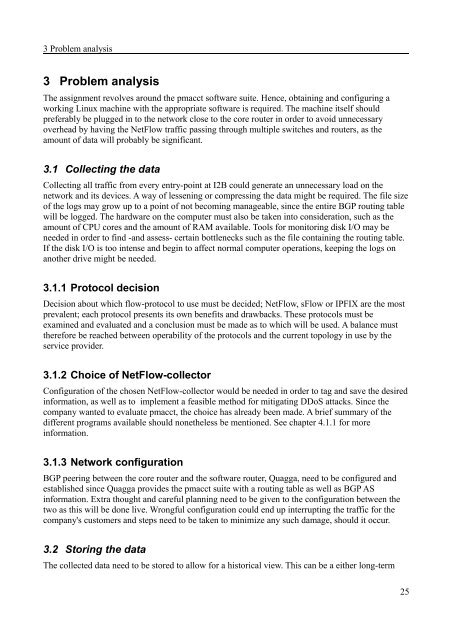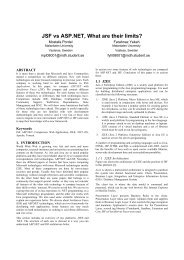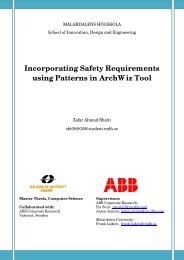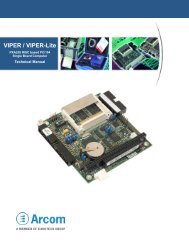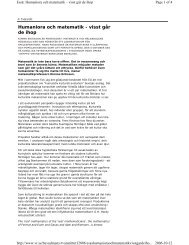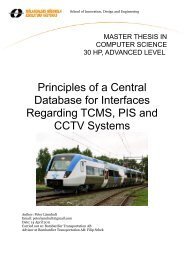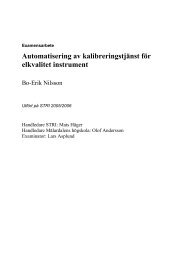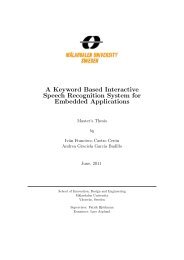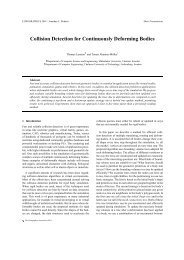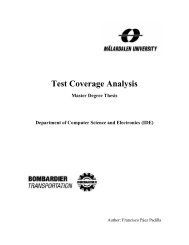Implementation of data collection tools using NetFlow for statistical ...
Implementation of data collection tools using NetFlow for statistical ...
Implementation of data collection tools using NetFlow for statistical ...
You also want an ePaper? Increase the reach of your titles
YUMPU automatically turns print PDFs into web optimized ePapers that Google loves.
3 Problem analysis<br />
3 Problem analysis<br />
The assignment revolves around the pmacct s<strong>of</strong>tware suite. Hence, obtaining and configuring a<br />
working Linux machine with the appropriate s<strong>of</strong>tware is required. The machine itself should<br />
preferably be plugged in to the network close to the core router in order to avoid unnecessary<br />
overhead by having the <strong>NetFlow</strong> traffic passing through multiple switches and routers, as the<br />
amount <strong>of</strong> <strong>data</strong> will probably be significant.<br />
3.1 Collecting the <strong>data</strong><br />
Collecting all traffic from every entry-point at I2B could generate an unnecessary load on the<br />
network and its devices. A way <strong>of</strong> lessening or compressing the <strong>data</strong> might be required. The file size<br />
<strong>of</strong> the logs may grow up to a point <strong>of</strong> not becoming manageable, since the entire BGP routing table<br />
will be logged. The hardware on the computer must also be taken into consideration, such as the<br />
amount <strong>of</strong> CPU cores and the amount <strong>of</strong> RAM available. Tools <strong>for</strong> monitoring disk I/O may be<br />
needed in order to find -and assess- certain bottlenecks such as the file containing the routing table.<br />
If the disk I/O is too intense and begin to affect normal computer operations, keeping the logs on<br />
another drive might be needed.<br />
3.1.1 Protocol decision<br />
Decision about which flow-protocol to use must be decided; <strong>NetFlow</strong>, sFlow or IPFIX are the most<br />
prevalent; each protocol presents its own benefits and drawbacks. These protocols must be<br />
examined and evaluated and a conclusion must be made as to which will be used. A balance must<br />
there<strong>for</strong>e be reached between operability <strong>of</strong> the protocols and the current topology in use by the<br />
service provider.<br />
3.1.2 Choice <strong>of</strong> <strong>NetFlow</strong>-collector<br />
Configuration <strong>of</strong> the chosen <strong>NetFlow</strong>-collector would be needed in order to tag and save the desired<br />
in<strong>for</strong>mation, as well as to implement a feasible method <strong>for</strong> mitigating DDoS attacks. Since the<br />
company wanted to evaluate pmacct, the choice has already been made. A brief summary <strong>of</strong> the<br />
different programs available should nonetheless be mentioned. See chapter 4.1.1 <strong>for</strong> more<br />
in<strong>for</strong>mation.<br />
3.1.3 Network configuration<br />
BGP peering between the core router and the s<strong>of</strong>tware router, Quagga, need to be configured and<br />
established since Quagga provides the pmacct suite with a routing table as well as BGP AS<br />
in<strong>for</strong>mation. Extra thought and careful planning need to be given to the configuration between the<br />
two as this will be done live. Wrongful configuration could end up interrupting the traffic <strong>for</strong> the<br />
company's customers and steps need to be taken to minimize any such damage, should it occur.<br />
3.2 Storing the <strong>data</strong><br />
The collected <strong>data</strong> need to be stored to allow <strong>for</strong> a historical view. This can be a either long-term<br />
25


